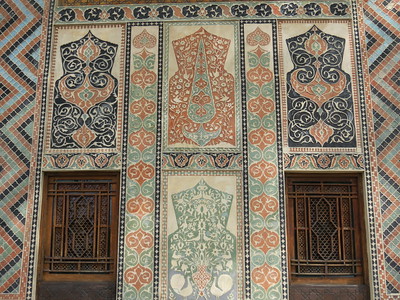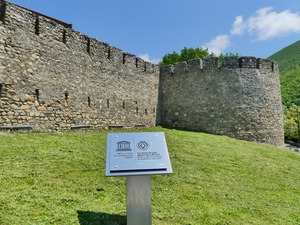Sheki

The Historic Centre of Sheki with the Khan’s Palace is an 18th-century trade town known for its silk farming.
Sheki was the capital of the short-lived Shaki Khanate, with the Khan’s palace as one of its most notable remaining landmarks. The urban plan was geared towards sericulture, with a hydraulic system distributing the water to the cultivated gardens with mulberry trees and residential houses with spacious attics to accommodate silkworm breeding.
Community Perspective: traditional architecture and small-town feeling in a beautiful setting in the foothills of the Caucasus Mountains, with the Sheki Palace as the most memorable monument with abundant and detailed decoration both in- and outside.

Map of Sheki
Community Reviews
Clyde

I visited this WHS in 2023 and it really is worthwhile destination when visiting Azerbaijan. Located in the north of Azerbaijan, Sheki is so deeply hidden in the mountain valley of the Greater Caucasus that only red tile roofs and pointed tops of minarets can be seen amidst the dense greenery of the gardens when viewing from above (perhaps the best panoramic viewpoint of the old city is from beneath the World War II Memorial).
The biggest changes in Sheki's old neighborhoods since the early Middle Ages occured mainly during the Soviet Union era (you will surely notice the prevalence of old Lada cars!). The current peaceful setting of Sheki came about through millenia of turbulence in the region. Three millenia ago, Sheki (then called Sakesana or Sake, was one of the most famous cities in Caucasian Albania and at the beginning of the first millenium AD, the doctrine of Christ was brought to Sheki, and the first Christian churches were built here and independent Albanian dioceses arose (the small Church of Kish is definitely worth a visit while in Sheki). Sheki is also a city that stood on the Great Silk Road and once huge bazaars rumbled on the squares, and merchants invited buyers into their tents in dozens of languages and dialects, seducing them with the wonderful aromas of seasonings (the excellent and tasty purple "sumak" springs to mind), a rainbow of luxorious fabrics, the glitter of jewels and the sharpness of foreign swords. A few family-run silk scarf or "kelaghayi" workshops are still open and if you're lucky enough you can see the traditional wax-resist method which involves stamping paraffin oil onto the fabric with a wooden block then dip-dyeing it. The wax is then rinsed away, leaving buta (paisley-like) ornaments and other patterns behind on the scarves.
In the 7th century, Sheki was occupied by the troops of the Arab Caliphate. The power of the Arabs was short-lived, largely due to the fact that the people of Sheki took part in the struggle against them under the leadership of the legendary Babek. In the 15th century, Sheki fell under the rule of Tamerlane. Battles were common as can be deduced by the huge upper fortified walls of the Sheki Castle or Fortress (or if you feel like hiking, the Khan's Pasture trail from behind the Sheki fortress leads to the Galarsan-Gorarsan Fortress). The best part of Sheki is getting lost in the steep old streets with cobblestones, especially between the city's two caravanserai (you can either book your own room in one of them or else visit for free during daytime).
Built in the 18th century during the Sheki Khanate period when Sheki was the capital, the best highlight of the city is the Khan's Palace, both for its exterior and its interior decorations. The huge stained glass windows or "shebeke", each square metre of which consists of 5,000 lattice-like pieces, adorn the facade of the palace and at the same time the light that passes through them produces lots of colours inside which reflect all around the rooms on the several pieces of glass of the Qajari-style mirrored niches. The layout of the palace's two floors does not differ, with three rooms in a row that separate the hallways, and both main rooms on the lower and upper floors are truly splendid even though with no furniture. The personal chambers of the khan were located on the second floor and according to custom, only members of his family, servants and close friends had access to it. The women's part of the second floor is painted mainly with flowers and oriental ornaments (the pomegranate wall paintings reminded me of the beautiful hill fort interiors of Rajasthan, India), while the central hall of the men's half, where the khan spent time with guests, is dominated by frescoes of Azerbaijani miniature. Here you can find scenes of hunting for animals and birds, elephants and even dragons, as well as pictures of battles demonstrating the military might of the Sheki khanate.
The only negative points of my visit here were the strict no photography inside policy, with CCTV cameras on wooden stands inside and the truly ugly steel barrier before entering the palace building (which could easily be removed if entrance to the small palace gardens would be only granted to ticket holders). On the other hand, thanks to this policy, I revisited a number of other times especially just before closing time (as the afternoon light is best on the facade). Although the facade is pleasant with beautiful decorative plasterwork showing peacocks and Islamic-inspired motifs in salmon, black and blue, definitely do not skip visiting the interior which is the true highlight. Of the 10 years it took to complete the palace, eight of those years were spent on the interior alone! The same strict no photography policy is adopted inside the Shakikhanov's house or palace, which nonetheless is also worth visiting mostly for its main room interior paintings and colourful shebeke. Wall painting subjects here include heroes from Persian poetry, among birds, animals and floral designs.
The Sheki Khanate existed until the early 19th century, when it became part of the Russian Empire. This was the heyday of arts and crafts, science and literature. In 1829, the first factory in Azerbaijan was built in Sheki. Silk weaving, agriculture and fishing were booming. The red brick facades of several buildings reminded me of similar architecture in Central Asia (especially the buildings in the Sari Toprak neighbourhood), while Sheki's ambience with a river passing right through the city reminded me mostly of Safranbolu, Turkey, and Berat or Gjirokaster in Albania. Other noteworthy monuments in Sheki (where there are a number of metal UNESCO WHS inscription plaques) are: the round Three Saints Church, built by the Caucasian Albanians but used as a Russian Orthodox Church during the imperial period, the old silk factory, established in 1928 and now abandoned with its delapidated twin lion statues at the entrance, the Gileyli minaret (now with a wooden covered staircase), the newly reopened Khan's mosque and museum, and the Yeralti "underground" hammam.
Last but certainly not least, the food in Sheki is really delicious. There are countless dishes and treats: you can't miss Sheki's Piti (a chunky, aromatic stew made from lamb, chickpeas, chestnuts and various vegetables), Sudlu Ash (plov flavoured with apricots and served with a thin egg omelette and lula kebab on the side), Lapali chorak (a sour bread made in Kish using walnuts, white onion and cherry syrup) and of course some Halva (made by layering nuts with thin pastry) for dessert. All in all, Sheki was certainly a highlight of our trip in Azerbaijan together with Nakhchivan and overall, a worthy addition to the WH list.
Juha Sjoeblom

Site visited October 2014. While the majority of tourists in Azerbaijan may not go outside the area of Baku, Sheki is an excellent reason to go there. It is a good place to see the other side of this country as opposite of Baku: traditional architecture and small town feeling in a beautiful setting on foothills of Caucasus Mountains. And the icing on the cake is the exquisite Khan’s Palace. That was also in my mind when I headed to Sheki.
At nine in the evening I hopped on a Sheki bound night train at the Baku railway station. The trip would last 10 hours. I had a bed in a four bed sleeper cabin. In the cabin were also a local father with a child and a granny. They were very friendly and in the beginning of the trip we had a cup of tea and biscuits together. They could speak only few words of English but still we could communicate with each other. At seven in the next morning the train left me alone in the darkness at Sheki railway station which is 15 kilometres away from the city. I waited at the station almost an hour for a taxi to show up.
From the centre of the city I walked along the main thoroughfare of the old city towards the Khan’s Palace. The city was just waking up. It was very quiet and you could see hardly anyone on the streets. Finally I reached the Khan's Palace which is surrounded by crumbling walls of Sheki Fortress. This 18th century palace is many times referred as 'little gem' and that is really true. The building is small, beautiful and nicely restored. It has abundant and detailed decoration both outside and inside.
It is possible to visit inside the palace only with guided tour which takes some 20 minutes. Photography is not allowed inside and you have to put plastic covers on your shoes for not to damage the wooden floors. While the exterior of the palace is nice with coloured geometric patterns, the interior is simply stunning. The centrepiece of this two-storied building is the big glass mosaic window which is assembled from pieces of wood and coloured Venetian glass. Each of the six rooms have their own style of decoration. The miniature paintings with exceptionally bright colours are especially admirable: pomegranate trees, birds and flowers. Maybe the most interesting single motive is the painting of ancient battle scene. Otherwise there are lots of floral and geometric ornamentations. I think ’perfect’ and ’complete’ are the right words to describe this beautiful little building. You can compare it to some of the finest palaces in Iran but in a smaller scale and in this strange rural setting.
Old city of Sheki is also included in the nomination. While I found it quite nice I don't know how authentic and consistent it is. Some buildings have been recently restored and some of them seemed a bit overrestored. Basically all the important buildings are located along one street which heads towards the Khan's Palace. There are some nice traditional houses, brick mosques, bath houses and two caravanserais, one of which is nowadays a nice hotel and restaurant.
Highly recommended side trip from Sheki is the village of Kish with its Albanian church. Taxi from central Sheki to Kish takes about 20 minutes. Kish is very nice traditional village with narrow winding alleys and stone houses. While I found the village itself quite interesting, the Albanian church of Kish is the usual reason to go there. While it looked a bit like Armenian church it is said to be Caucasian Albanian.
In Azerbaijan there are not many places that you can call lovely or idyllic. There is grandiose and luxurious Baku, ugly and smelly oilfields, some dull and dusty plains. To my experience Sheki is the nearest thing to idyllic in Azerbaijan. For me the trip to Sheki gave another perspective to this country. Is this nomination enough for inscription? For Khan's Palace for sure, but is it enough. For the old city, I'm not that sure. At least I hope that Sheki with Khan’s Palace could make it because it is maybe the best option among Azerbaijan's current tentative list.
Els Slots

This is a site probably few have heard of – I also did not know about it until I started preparing for my trip to Azerbaijan and stumbled upon this (then) TWHS. Sheki has been an independent country between 1743 and 1813 after it wriggled itself free from Persia. It lies in the far north of Azerbaijan, just below the snow-capped peaks of the Greater Caucasus and the border with Russia. The nomination Sheki, the Khan’s Palace covers more than the palace alone: the town’s trade and industry neighborhoods and vernacular architecture are included as well.
Sheki was the main center of silk production in the Caucasus. It was an important stop on the trade route between “the Dagestan Mountain Traders and the main East-West Caucasus Route”, according to my Trailblazer Guide to Azerbaijan. During my trip, I stayed for 2 nights in one of the two large former caravanserais in the old town: the 18th-century Yuxari Caravanserai. Its grounds are nicely renovated, although the rooms are a bit damp and moldy. But I did enjoy sitting in the little alcove in front of my room in the evenings.
The houses in the old part of Sheki town are all built in a similar style: their walls are a mix of brick and cobblestones, plus wooden windows. It’s a nice and quiet place to walk around, although unfortunately there’s not much you can enter.
The undoubted highlight of Sheki is the 18th-century summer palace of the Khan. It was constructed in 1762, so it dates from exactly the period that Sheki was an independent state. The palace and related buildings are located above the city in a walled enclave. The palace facade is quite stunning: it consists partly of wood and partly of stone decorations. It is located in a little garden with two old plane trees in front of it.
Inside you’re not allowed to take pictures, but it is even nicer than the exterior. The wooden windows are inlaid with pieces of colored glass, adding magical sunlight to the rooms. The palace is not that big, it has 6 different rooms. It was only used for business purposes, the khan’s family lived elsewhere. The main areas such as the reception hall and throne room are fully covered in murals. Most of it is figurative, but there are also hunting scenes and lively images of the victory of the army of Sheki over Persia (including heads on sticks).
The grounds further contain a museum that seems not to have been refreshed since the communist era. It’s nice enough for a short visit though, it has some archaeological findings and Lenin memorabilia. Another building is set up as a shop for artisans who make specific wooden windows with stained glass, called shebeke. A young man shows how it is made: tiny pieces of wood and glass are put together like a jigsaw puzzle (without glue or a single nail).
In hindsight, the Sheki Palace was the most memorable monument that I visited in Azerbaijan. It has a very distinct architectural style that I haven’t seen anywhere else in the world. Also, it has been well-kept. It provides an eye into the past of what is now the Republic of Azerbaijan.
Read more from Els Slots here.
Community Rating
- : Vernon Prieto
- : Ana Lozano Ali Zingstra
- : Sutul JobStopar
- : Els Slots Alexandrcfif Voyager Walter George Gdanski Philipp Leu Rodinia MH Tarquinio_Superbo
- : Rich Forrest Clyde Pchxiao Afshin Iranpour Thomas van der Walt Ken DJ Hammeel Alexander Barabanov Kurt Lauer Bin Wojciech Fedoruk
- : Juha Sjoeblom Ludvan CugelVance
- : Krijn Marcel staron Szucs Tamas
- : Alexander Lehmann AC Zoë Sheng
- : Yevhen Ivanovych
Site Info
- Full Name
- Historic Centre of Sheki with the Khan’s Palace
- Unesco ID
- 1549
- Country
- Azerbaijan
- Inscribed
- 2019
- Type
- Cultural
- Criteria
-
2 4
- Categories
- Urban landscape - Post-medieval European
- Link
- By ID
Site History
2019 Advisory Body overruled
ICOMOS had recommended Not to Inscribe, overturned by amendment lead by Kuwait
2019 Inscribed
2017 Referred
2017 Advisory Body overruled
ICOMOS recommended Not to inscribe
Site Links
Unesco Website
Official Website
In the News
Connections
The site has 12 connections
Art and Architecture
Constructions
Geography
History
Human Activity
Timeline
Visiting conditions
World Heritage Process
Visitors
88 Community Members have visited.
The Plaque
 (photo by Clyde)
(photo by Clyde)